There is a certain dramatic event known to our faith that surpasses even the efforts of the best storytellers to depict what really happened. That’s because it took place, not in human history, but as the opening act of salvation history, before earthly time began.
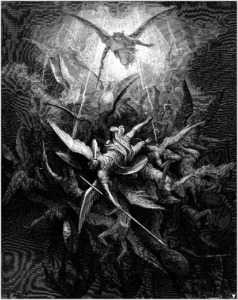 It was a deadly conflict of angels.
It was a deadly conflict of angels.
Falling Like Lightning
The best description we have of the event had to come from Scripture, that is, from God Himself, who was witness to the war.
(Photo at right: Gustave Doré, 1781)
The story takes up the whole of Chapter 12 of the Book of Revelation, and it is extremely cryptic. It gives only the broad strokes. I don’t think the human mind can really comprehend the nature or ferocity of what took place.
Then war broke out in heaven; Michael and his angels battled against the dragon. The dragon and its angels fought back, but they did not prevail and there was no longer any place for them in heaven. The huge dragon, the ancient serpent, who is called the Devil and Satan, who deceived the whole world, was thrown down to earth, and its angels were thrown down with it. (Rev 12:7-9)
Perhaps you recall the words of Jesus to His disciples when he told them that He saw Satan “fall like lightning from the sky” (Lk 10:18).
That might have been the devil’s real-time reaction to the disciples’ initial preaching of the Good News, but it is equally possible that Jesus “saw” this scene with His divine eyes before time began because He was there when it happened.
Our Blessed Guardian Angels
The story does, however, give us a window of understanding into the Church’s teaching about guardian angels. Something at the end of the same chapter gives us a clue:
When the dragon saw that it had been thrown down to the earth, it pursued the woman who had given birth to the male child….Then the dragon became angry with the woman and went off to wage war against the rest of her offspring, those who keep God’s commandments and bear witness to Jesus. (Rev 12:13.17)
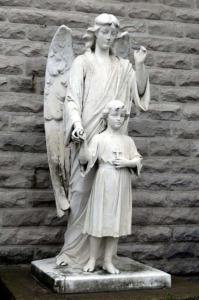 After the demons’ expulsion, the deadly conflict of angels takes place, not in heaven, but on earth. It is the primary reason to be grateful that God has sent His Guardian Angels to protect us!
After the demons’ expulsion, the deadly conflict of angels takes place, not in heaven, but on earth. It is the primary reason to be grateful that God has sent His Guardian Angels to protect us!
“If the devil could do as much harm as he wished,” said St. Augustine, “there would be no just man in the world.” In essence, without the Guardian Angels, no human could survive the seductions of the fallen angels to evil, and he is right.
The Church’s teaching, as always, gives us hope. It acknowledges that the devil and his minions are powerful but also that they are subordinated to the power of the angels who work constantly to assure our protection from spiritual evil in this world.
The Fall of the Angels in Art
Hollywood depicts all kinds of fallen human beings, but it seems to be harder for them to make movies about fallen angels. Personally, I think it’s because the Hollywood elites don’t want to cast a negative light on the spirits they worship, but that’s just my opinion. Nowadays, Hollywood is certainly plenty of occult-themed movies, which is not the least bit positive for our culture.
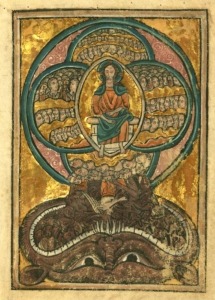 Thankfully, real Christian artists through the ages have not shied away from the topic and have depicted it for what it was: the punishment of God’s firstborn sons for their apostasy. In fact, it’s one of the favorite themes of medieval and Renaissance art which should not surprise us because those were ages of faith.
Thankfully, real Christian artists through the ages have not shied away from the topic and have depicted it for what it was: the punishment of God’s firstborn sons for their apostasy. In fact, it’s one of the favorite themes of medieval and Renaissance art which should not surprise us because those were ages of faith.
(Medieval manuscript depicting the Fall of the Rebel Angels, ca. 1290 AD. Notice the open jaws at the bottom.)
Christian artists painted the conflict with a high degree of religious imagination and artistic ingenuity, and you can’t blame them. It’s a dramatic scene, isn’t it? It also fit perfectly with the preaching of hellfire and brimstone in the ages before most priests forgot that Hell exists.
The real masters of this theme were the dour Northern Europeans (German, Flemish, and Dutch) who loved depicting the gore with intense detail and color. My favorite is by Pieter Brueghel the Elder (Netherlands, 1562), who holds nothing back in his amazing canvas.
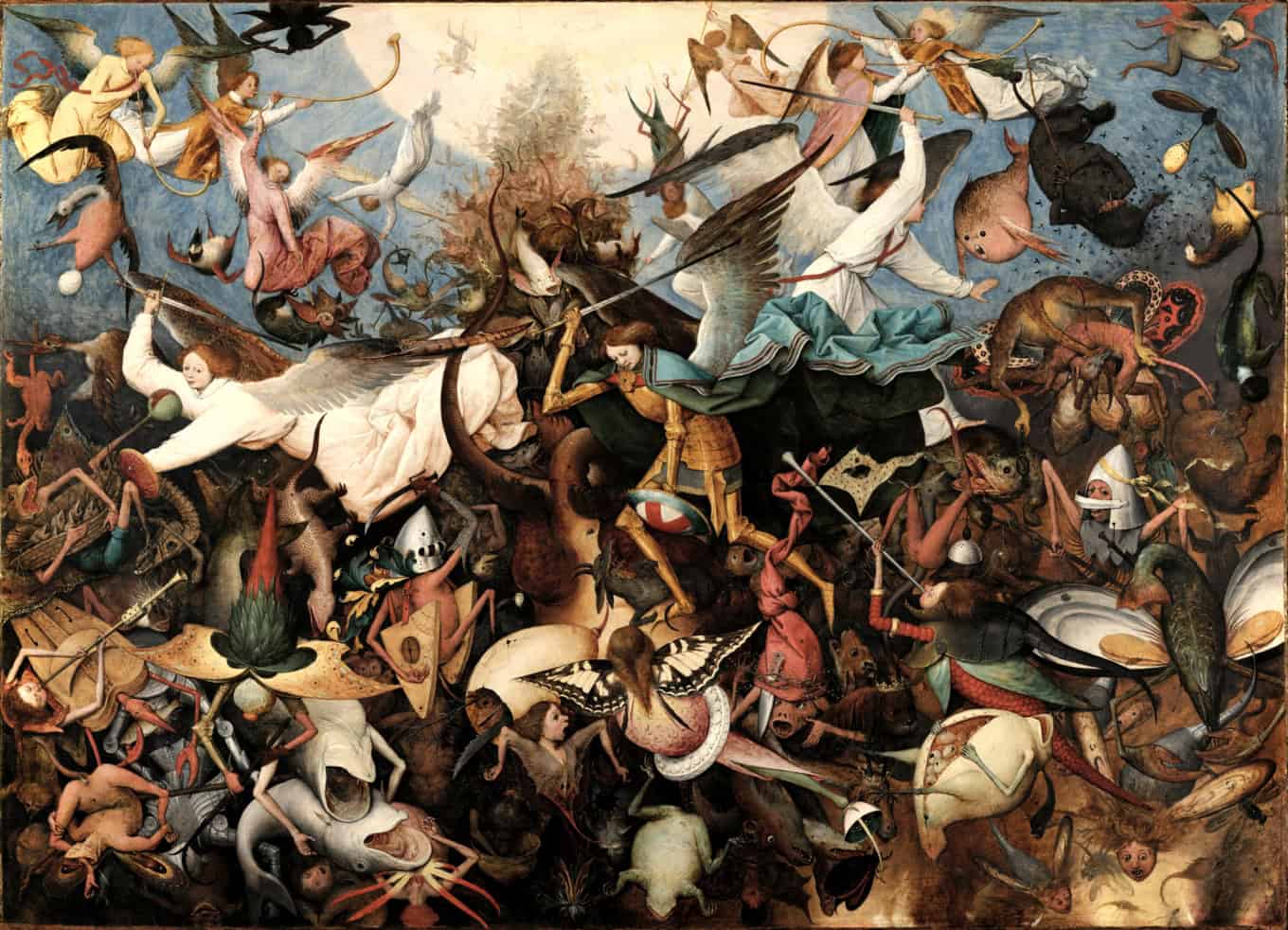
Breugel’s St. Michael stands in the middle of the scene (with the flowing blue cape) hacking away at Satan while his companion archangels in white on either side of him expel the other hideous rebels from heaven. It’s a little hard to decipher the internal chaos of the scene without looking at it very closely, but its demonic depictions are accurate to the theme and quite brilliant.
It’s a universal theme. The story of the fall of the angels is not explicitly told in the Hebrew Bible, but it is very graphically recounted in the Jewish apocalyptic literature such as the Book of Enoch and the Book of Parables. Numerous places in the Islamic Koran recount stories of the fall or the punishment of the rebellious angels as well.
The Fall of the Angels in Sculpture
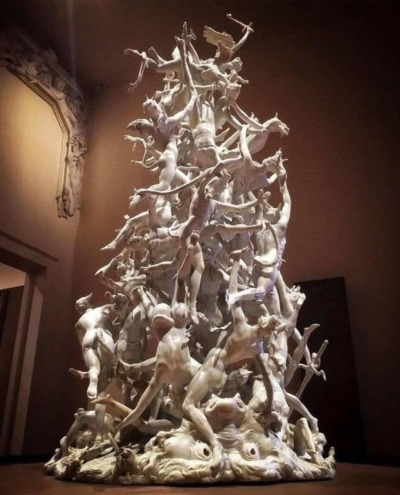 I’ve reserved my greatest words of admiration for the best work on this theme, which is an extraordinary sculpture called, the “Fall of the Rebel Angels.”
I’ve reserved my greatest words of admiration for the best work on this theme, which is an extraordinary sculpture called, the “Fall of the Rebel Angels.”
If you can imagine someone carving Peter Breugel’s chaotic scene into a three-dimensional piece of marble, then you will not be surprised that it was done by a Venetian artist named Francesco Bertos, who sculpted it sometime between 1725 and 1730. Italians were the unqualified masters of the art.
I’m sure you’ll agree with me that this work is utterly astonishing. If a picture paints a thousand words, as they say, a walk-around sculpture probably paints ten thousand.
Amazingly, it was sculpted from a single block of Carrara marble, and there are over sixty figures in this composition, including ferocious animal faces, snakes, demonic monsters, and a lizard-like creature on the very floor.
It’s hard to see in perspective, but the sculpture stands five-and-a-half feet high, the normal height of a man in Bertos’s time. Its base is nearly three feet wide (32 inches).
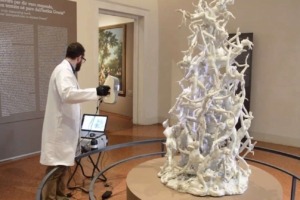 For centuries this masterpiece was thought to be the work of a modest stone cutter from Vicenza (less than 40 miles from Venice in northeastern Italy.) But scholars have concluded that Bertos was the actual sculptor because his style is unmistakable: several of his earlier works also feature multiple figures arranged in in a gravity-defying pyramidal structure, anticipating the style of the “Fall of the Rebel Angels.”
For centuries this masterpiece was thought to be the work of a modest stone cutter from Vicenza (less than 40 miles from Venice in northeastern Italy.) But scholars have concluded that Bertos was the actual sculptor because his style is unmistakable: several of his earlier works also feature multiple figures arranged in in a gravity-defying pyramidal structure, anticipating the style of the “Fall of the Rebel Angels.”
In the mentality of the age, such intricate works were thought to be humanly impossible to create. Because of that, Bertos was actually accused of witchcraft in 1737! He proved his accusers wrong by carving a similar sculpture right before the eyes of the judges of the Inquisition—pretty impressive.
Let’s look a little more closely at some details.
Defiance and Punishment
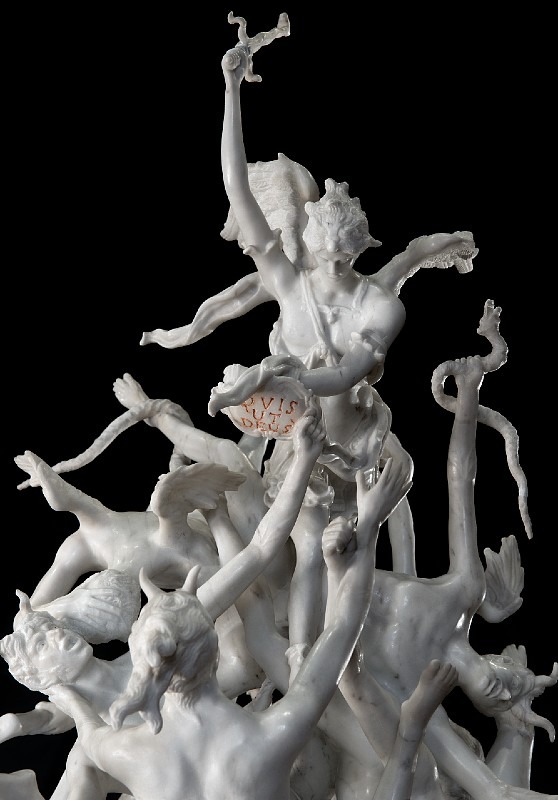
At left: St. Michael the Archangel stands at the very pinnacle of this pyramid, identified by the words on his shield: “Quis ut Deus” (“Who is like unto God?”) In Hebrew the same phrase sounds like Mi-cha-el, hence the great archangel’s name.
At right: That phrase is Michael’s battle cry against Lucifer, who is depicted as wearing a crown and standing at the very bottom of the pit pointing his finger up at God in defiance.
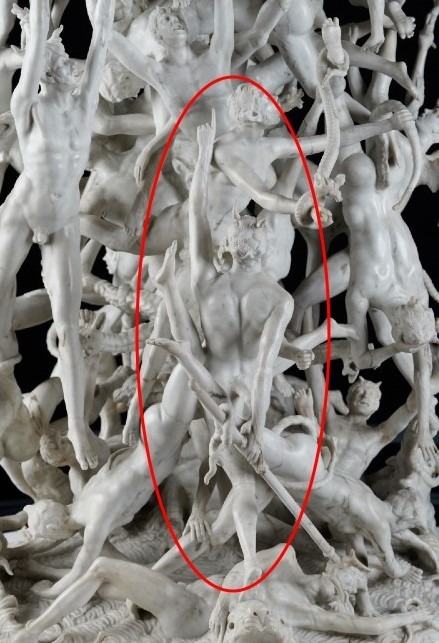
The movement of Michael at the top chopping down with his sword is deliberately juxtaposed against the movement of the Evil One raising his arm in blasphemy against his Creator. Michael will have none of it. Hence, the angelic conflict is written into the very marble.
The Theology of the Fall
Then there is a certain theological point that Bertos made with these figures which tracks perfectly with the Church’s teaching about the demons’ rejection of God’s grace.
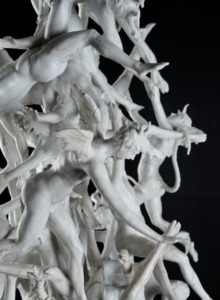 Look closely at the transformations of the apostate angels into demons as they are falling out of heaven:
Look closely at the transformations of the apostate angels into demons as they are falling out of heaven:
- Horns are emerging from their heads
- Hair starts to resemble reptilian scales;
- Tails and bat-like wings spring from their backs;
- Fire issues from a few of their mouths, and most of them, if not all, are screaming in terror.
You will also notice snakes winding in and through sculpture, some of which are biting at the fallen angels.
[The video below shows many more intimate details of the sculpture, and I highly recommend taking 4 minutes to view it.]
Perversions of Nature
This incredible sculpture paints a more vivid picture of the tortures of the damned than a thousand sermons could. The theological point, however, is even more precise than just the general suffering of those who choose hell. It is this: the rejection of God’s grace drastically distorts even the gifts of nature.
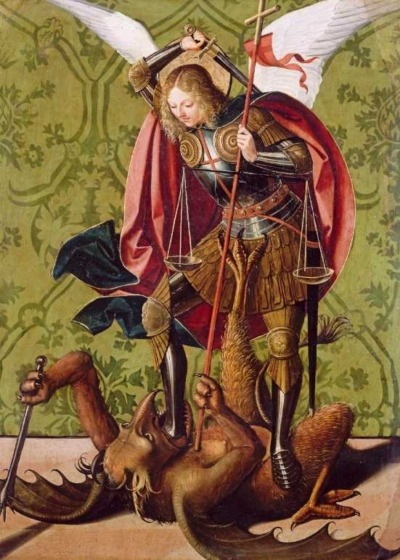 Case in point: the grace-filled beauty of the holy angels is so ravishing that humans can barely stand to see their glory. In contrast, the demons have hideously perverted features that literally transform their glorious nature into the semblance of creatures lower than the animals.
Case in point: the grace-filled beauty of the holy angels is so ravishing that humans can barely stand to see their glory. In contrast, the demons have hideously perverted features that literally transform their glorious nature into the semblance of creatures lower than the animals.
The paragon of this awful transformation is Lucifer himself who once was the most glorious angel in heaven. In Revelation, his true face comes to light: he turned into a revolting and malevolent dragon in whom is found no goodness whatsoever.
Our theology also says the fallen angels cannot repent of their evil because their wills are fixed in defiance. That is a result of the ferocity of their angelic wills, which are unchangeable once they make a decision. Their rejection of God is total and irrevocable.
In other words, sculpture is a more fitting medium than a painting to depict their fate because the free choice they made to reject God is literally set in stone.
———-
PHOTO CREDITS
Museum Photos: Courtesy of the Intesa Sanpaolo Collection, Francesco Bertos (documented from 1706 to 1739), Fall of the Rebel Angels, 1725-1735, Carrara marble, 168 x 80 x 81 cm, Gallerie d’Italia – Vicenza, Credits: Archivio Patrimonio Artistico Intesa Sanpaolo / ph Valter Maino, Vicenza.
Other Photos: Man standing next to sculpture (Artifacts Museum); Feature: Michael with Sword (Dosso Dossi, Public domain, via Wikimedia Commons); Guardian Angel (Nheyob); Altenburg Abbey (Wolfgang Sauber); Pieter Brueghel the Elder (Public domain, via Wikimedia Commons); Hieronymus Bosch (Haywain Tryptich); Gustave Dore (Public domain); Medieval (William de Brailes); Devil under foot (Josse Lieferinxe); End Photo (El Club del Arte_FB Page).
———-
[Note: This article is a reproduction of the Sacred Windows Email Newsletter of 10/6/24. Please visit our Newsletter Archives.]
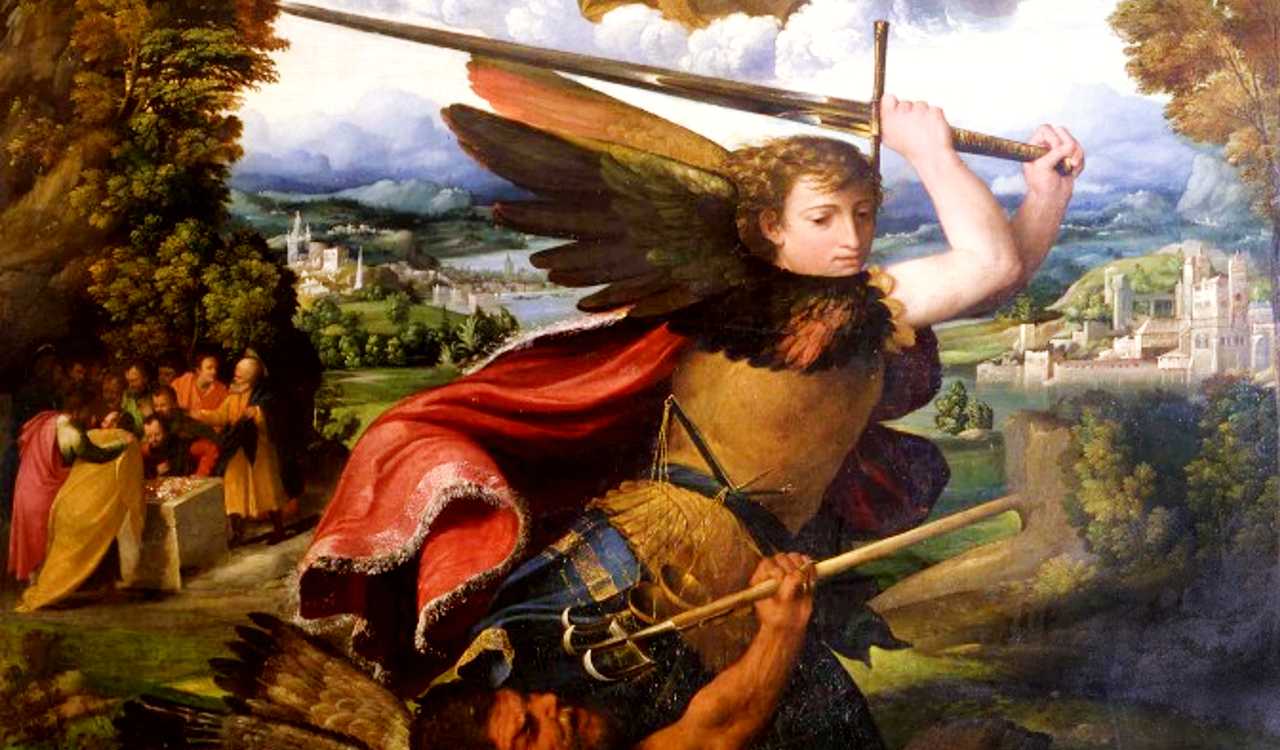
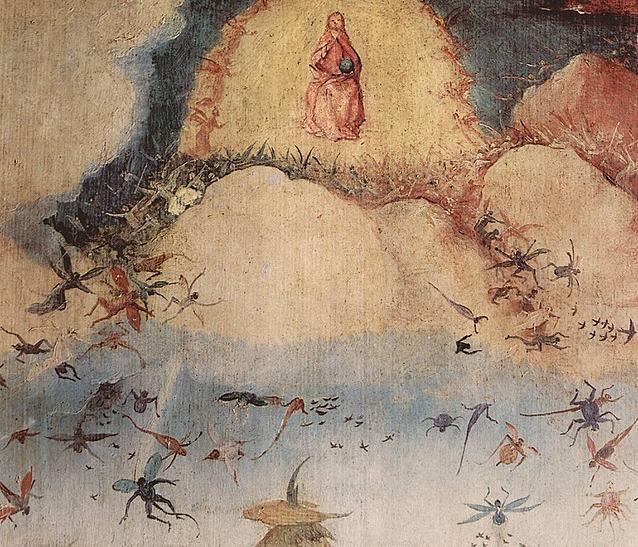
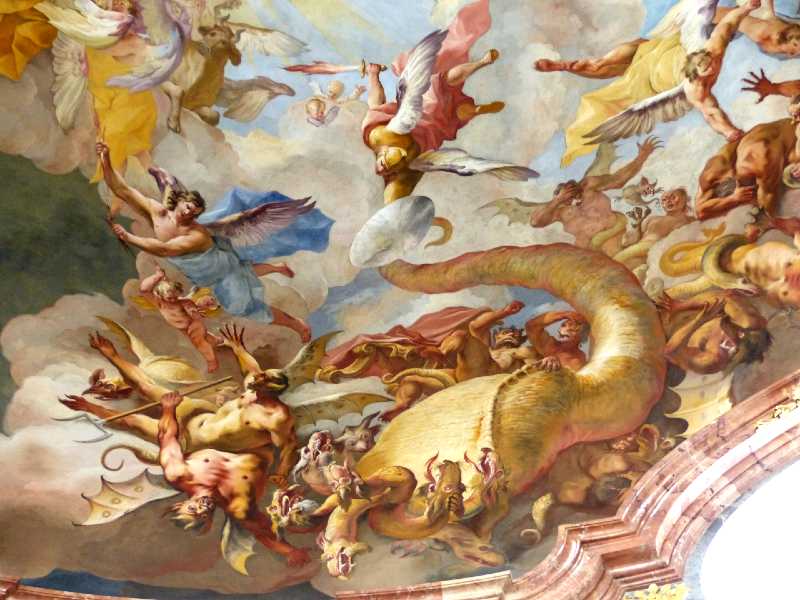
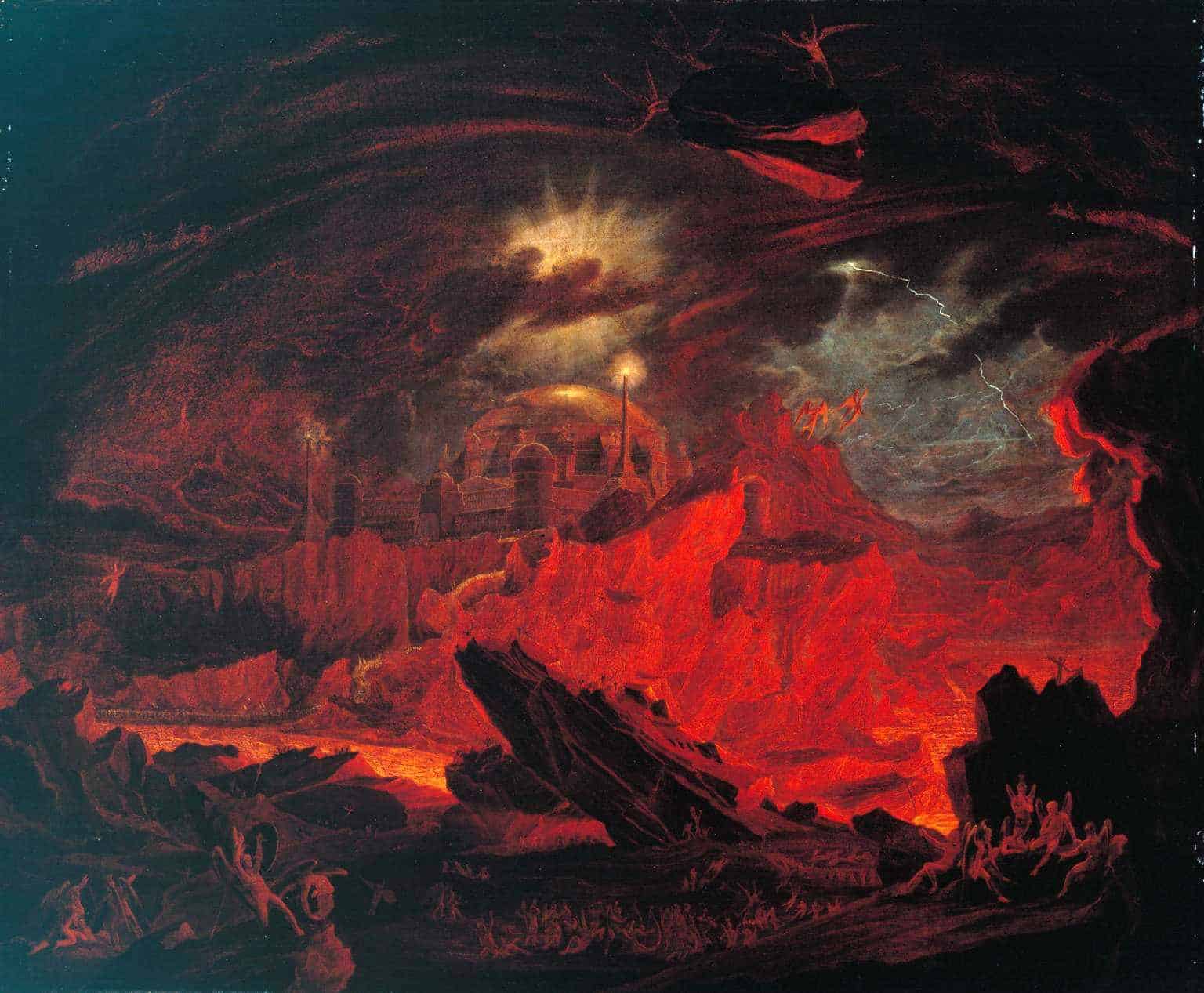
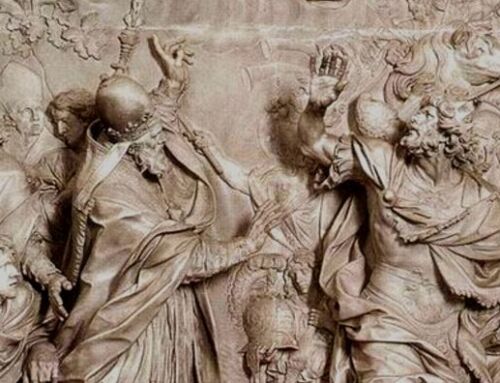
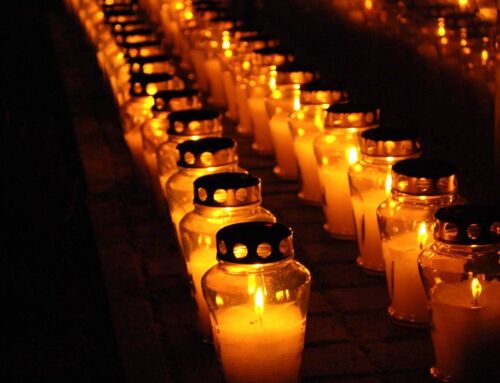
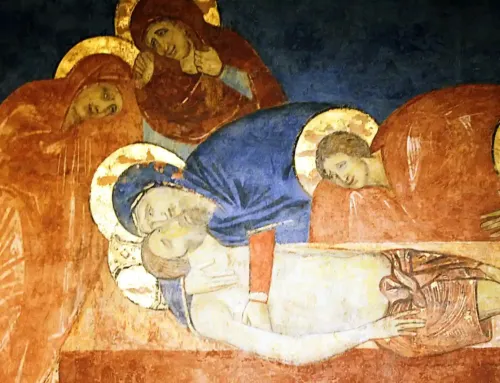
tzy9ad
Great article and Church teachings on the fallen angels. There are videos out there that suggest that satan has had a conversion of heart . That is so misleading to the youths What a great lie is being told to them and makes them think he is a victim. It surprises me that people do t leave comments on your articles. Before today I had never come across your website.